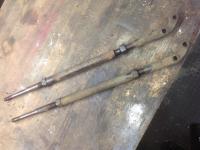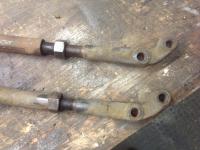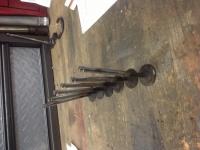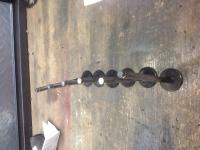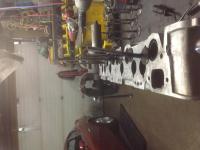Everything posted by zKars
-
Bought January 1970-build 240Z, need some parts and info
Welcome back to the addiction. Knew you would be back. Nice choice of vintage. What part of Canadia are you from? There are lots of us brethern near by likely with lots of extra's to share. The site you were searching for is zhome.com Yes, its Carl's baby. Let us know more, and post pictures of your new baby. Welcome!
-
Heater panel screws
Yup, I was dreaming about the .75 pitch. 4 x 0.7 is the correct pitch. Definitely not 8-32 though
-
Heater panel screws
4mm x 0.75. Slight chance they are 5 x .8 can't check till I get home. One or the other for sure.
-
Cam Wear
Few things come to mind looking at all the evidence so far. 1. Since the cam bearings are supplied by the same oil path as the lobe holes, I'de be curious to look at the #1 cam tower bearing/cam bearing and see if it looks any different (ie worse) than the other four. 2. And along the same lines as #1, judging by the way oil gets to those lobe holes, if its only #1 not getting oil, then its a plug/restriction right there in that hole in that lobe, or #2 would be having problems too, as they share a common supply bore down the length of that cam. Therefore, I think, if you see the same oil volume coming out of #1 lobe as #2 in just-crank condition, then its not a lack of oil supply to just #1 that's causing this. 2. After it runs for few minutes, is there noticably less oil sitting around/on/over that lobe than any of the others? There is such a flurry of oil flying around under there under running its hard to imagine you would able to tell any significant difference. Also says that oil can even get #1 just by splash chance and keep it alive for more 1500 miles... 3. A close up magnified view of the first pic in post #10 of the rocker pad worst wear area is showing breakout and fracturing. I'm thinking the hardening of that particular rocker surface is not up to snuff and it gave out. 4. Also note the wear/damage is not even across that rocker surface, but is concentrated in ~ 25% of the width. Tells me the rocker pad is not flat across its width or is not hardened evenly. Just some thoughts. hope the rocker switch solves the mystery.
-
chinese dcoe $130
Just what every guy with a 68 Nova wants. A weber side draft bolted to his 4 barrel intake. Wait, maybe if he used a high rise manifold and had the weber sticking out of the hood, with the stacks facing forward! Now that is a dream come true! Might need a friends hand to do a triple face palm. (get it , "triple weber face palm", huh? ) ROFL
-
? on exhaust hangers
Perhaps you are just using terms they are not familiar with, but any exhaust shop that doesn't know how to properly hang the exhaust they are installing, regardless of make of car, should be avoided at all cost.
-
Adjustable T/C rods : Anyone seen these before?
and the winner of the "what thread size is that " contest, is, no surprise, Jon! perfect 5/8 x 18tpi thread.
-
Adjustable T/C rods : Anyone seen these before?
Wade I need $23.96 for postage on the expertly packaged TC rods. Paypal me $25 and we'll call it even. z240@shaw.ca Thanks! Jim
-
71 240z with l28e w/ SU carbs wont start... PLS HELP!!!
Eureka! Problem solved. The two inlets on top of the fuel bowls are both safe to put fuel in. The one that sticks straight up is the bowl vent (connects to air cleaner) the more complex one on the side/top that is angled is the fuel inlet. The very top of the round dome with the black plastic knob is where you add damper oil, you didn't somehow connect that to the gas supply did you?
-
Cam Wear
oh oh. I'de be removing the oil pump drive spindle and driving the pump with a drill and 3/8 rod with a flat ground on the end while watching the oil flow from every cam lobe. That way you get higher pressure and flow rate than while cranking. Remove the rockers so you can see them all flowing (or not) at once. Judge from there. Can I rush ship you a fresh stage 3'ish stock regrind and more fresh rockers? Hmmm, never thought of offering a cam rental service before....
-
71 240z with l28e w/ SU carbs wont start... PLS HELP!!!
The ceramic thing is your ballast resistor. Cracked is not critical, there is a fine resistor wire underneath it that can't be broken. the ceramic is just a heat proof place to put that wire as it gets hot doing its job. If the wire between its two terminals is broken, then the coil is not connected.
-
71 240z with l28e w/ SU carbs wont start... PLS HELP!!!
Welcome to the forum, sorry your first post has to be of the desparate kind. Well, the most likely thing you did to prevent starting is the spark plug wire remove/replace has them now in the wrong positions. You have the order right, but did you count CCW or CW? its CCW on the dizzy. Second thing, at TDC, #1 points forward toward the rad, kinda between the vacumm advance pot the cap clip. Is your #1 TDC rotor pointing backward toward the firewall? Maybe you were on the wrong piston stroke when you first found TDC. Pop the oil cap and find lobes for #1 pointing up (both are in front of the fill hole, get a flashlight) when the damper timing mark is at TDC compression stroke. So confirm #1 TDC compression stroke with the plug out, both #1 cam lobes pointing up, damper timing mark near to zero as you can get it, and then when you see where #1 is on the cap, (doesn't matter where that turns out to be) install them CCW from there. Who knows who might have previously assembled the dizzy and its drive spindle/oil pump in some crazy out of "normal" place position, and just fixed it by putting the plug wires as needed. Been done many times. Do you remember where #1 was on the cap when you removed the old wires? Not likely, but would have given you the reference you need now. Let us know how you make out.
-
Adjustable T/C rods : Anyone seen these before?
Wade, Alrighty. then! Didn't realize I gave the impression they were "free", so might have to charge you a $1 each, just to keep it legit and all official like. Mind you this isn't the classifieds, so they better be free or Milke will be all over me for illegal posting.... I'll package them up and send you a postal shipping cost tonight. Things must weight about 3 lbs each... And YOU get the pleasure of freeing up the lock nuts and threads on the other one.... One was enough for me. hahahahahah
-
Adjustable T/C rods : Anyone seen these before?
Never suggested adjustable T/C rods are new. I've had the original style AZC set on my Z for years. Allows me to never have the exact camber I want, ensures I always worry if the rod end lock nuts are staying tight, and produces a suspension compilance at a perfect bone jarring level that I love. Just wondering if anyone else had seen this particular brand or type of them or new who made them. Pure interests sake.
-
Adjustable T/C rods : Anyone seen these before?
No history from the PO. Its new to him as well. I'll check the thread Dia and pitch tonight and see how close Jon's eyeball guesstimate is. Anyone else want to guess? Little wager on the side, nudge nudge wink wink?? Looking this morning at the closeup picture of the control arm end, I'd swear the holes are drilled WAY off center relative to the casting shape on the top one. Bottom one looks alright. Makes me want to think these are reproductions. Might just remain wall ornaments.
-
Adjustable T/C rods : Anyone seen these before?
While working on yet another Z, I discovered these "gems". Any one seen these before? They appear to made from machined originals, the casting of the front end is too close. There is a fair bit of corrosion and pitting on the end where the bushings go, not sure if I want to risk using them. Interesting concept at least. Stock mounting and bushings, but adjustable caster. Anybody wants these (reads brave enough to try them) let me know...
-
Battery size
The stock battery is a 24F. Now let google be your friend. such as http://www.rtpnet.org/~teaa/bcigroup.html
-
240z bumper bolts
The pitch of those nuts on the car are 10 x 1.25 without doubt, at least as it came from the factory. Go buy a Harbour freight tap set and clean them up. Nothing you can put on the bolts you have will clean out those threads without harming its threads.
-
Distributor removal
Removing the distributor base at the 2 bolt location will require a new gasket for that connection unless this has been apart recently. The old one will separate. More trouble than its worth. Mark the plates (Sharpy!) where the 10mm headed timing adjustment bolt locks them together to note their alignment and take that one bolt out. Pull dizzy straight out, it can only go back in one way (tang at the end is offset, no 180 out is possible). Easy peasy.
-
How a simple valve adjust can ruin your whole day.
-
Can I use a 260/280z oil/temp gauge in my 1970 240z
The only other challenge is the difference in how the two gauge housings mount to the dash. It's best to put the guts of the 280 gauge into your 240 housing then adapt the wiring to match the wiring in your car. Both have the same wires, just not the same plugs. Just a bit of cutting and adding new connectors, or splice the 280 gauge wires to the connectors on your 240 gauge. It certainly can be done. Good luck!
-
High Oil Pressure
My understanding of oil pressure is that is caused by the balance of two controlling factors. One is the internal relief valve in the oil pump, and the other is main and rod bearing clearance. The pump relief is a spring pressure controlled device that just allows internal bypass at a certain max pressure, but the bearing clearance and pump volume determine the overall pressure over the range of normal operating conditions. I can't see one bad bearing causing high pressure. When the pump relief valve sticks, the pressure gauge becomes a tach, ie rpm determines pressure and it can quickly get WAY above 60 at as little as 3k. Doesn't sound like your case. Time to take it apart and diagnose. If its one bearing seized and the other have correct clearance and no sign of scoring and starvation, likely just a blocked passage to that bearing and bad luck...
-
Advice needed for selling my 1972 240Z
Gordon Welcome to classiczcars.com. This site has a classified section, feel free to post it here. Look at the other similiar z cars for sale and decide what yours might be worth. There are many Z owners here that are in your area. As Wade says post a couple of pictures in this thread, and I'll bet you'll get some quick response. A well cared for one owner car is much sought after. Good luck with the sale. And as Wade says, cash or nothing.
-
Where are all those moulds at?
i think Supertramp had it right when they wrote "Dreamer, you know you are a dreamer..."
-
electrical short
you got it now. Start button is perfect.




 Subscriber
Subscriber
